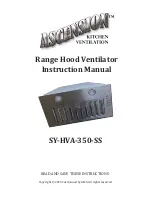
Caution: To reduce the risk of fire, use metal ductwork.
1. Decide where the ductwork will run between the ventilator unit and the
outside.
2. A straight, short duct run will allow the ventilator to perform most efficiently.
3. Long duct runs, elbows, and transitions will reduce the performance of the ventilator. Use as few of
them as possible. Larger ducting may be required for best performance with longer duct runs.
4. It is recommended that a 6” round metal duct be used.
5. The air must not be discharged into a flue that is used for exhausting fumes from appliances burning
gas or other fuels. Regulations concerning the discharge of air must be fulfilled.
6. Install a roof/wall cap. Connect round ductwork to cap and work back
towards hood location. Use duct tape to seal the joints between ductwork sections.
ELECTRICAL CONNECTIONS:
* Electrical wiring must be done by a qualified person(s) in accordance with all applicable local building
codes and standards.
TURN OFF ELECTRICAL POWER AT SERVICE ENTRANCE BEFORE WIRING
* If the supply cord is damaged, it must be replaced by the manufacturer, its service agent or similarly
qualified persons in order to avoid a hazard.
* Do not use the plug and an extension cord other than the ones initially provided with the unit.
INSTALLATION:
1. Attach the duct outlet adapter to the top
of the ventilator with the four screws provided.
Tighten securely.
2. The ventilator is designed to be operated
with a 6” exhaust duct.
4


























